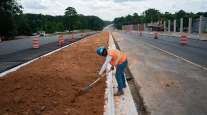US Economic Growth Rebounds on Inventory, Export Boost

U.S. economic growth picked up in the third quarter after an uninspiring first half of the year as a build in inventories and a soybean-related jump in exports helped cushion softer household spending.
The 2.9% annualized increase in gross domestic product, the value of all goods and services produced, was the biggest in two years and followed a 1.4% gain the prior quarter, Commerce Department data showed Oct. 28. The median forecast in a Bloomberg News survey called for 2.6% growth. Consumer spending, the biggest part of the economy, rose a less-than-projected 2.1%.
The data are in sync with the views of Federal Reserve policymakers that the economy is making slow and steady progress. At the same time, solid employment and steady income gains are a sturdy base for households to continue in the role as the economy’s main driver of growth, a contrast with the drag from business investment.
“The economy is good but not great,” said Stephen Stanley, chief economist at Amherst Pierpont Securities in New York. “The economy is going to continue to rise and fall with the consumer, and the best news there is that the underlying fundamentals are strong.”
Consumer purchases grew at about half the pace as in the previous three-month period, and corporate investment in equipment declined for a fourth straight quarter, the longest such stretch of the current expansion.
Inventories rebounded in the third quarter after shrinking in the prior three months, contributing to growth for the first time since early 2015. Exports accelerated, adding the most to GDP since the final three months of 2013.
To get a better sense of underlying domestic demand, economists look at final sales to domestic purchasers, which strip out inventories and exports. Such sales grew an annualized 1.4% last quarter after a 2.4% increase from April through June.
Central bank officials can point to evidence that growth is healthy enough to warrant raising interest rates, just not necessarily at the Fed’s gathering Nov. 1-2. Democrats and Hillary Clinton can claim the economy is improving, while Republicans and Donald Trump can just as plausibly say progress is tepid.
Economists’ GDP forecasts ranged from 1.3% to 3.6%. The estimate is the first of three for the quarter, with the other releases scheduled for November and December when more information becomes available.
Household purchases, which account for about 70% of the economy, grew at a slower pace after the prior quarter’s 4.3% jump that was the biggest since late 2014. The median forecast in the Bloomberg survey was also 2.6%. Purchases added 1.47 percentage points to growth.
After-tax incomes adjusted for inflation climbed at a 2.2% annual rate, after a 2.1% gain in the prior three months. The saving rate held at 5.7%.
Net exports added 0.83 percentage point to GDP growth. Trade and inventories are two of the most volatile components in GDP calculations.
The Commerce Department said that the acceleration in overseas shipments was mostly attributable to an increase in exports of soybeans, indicating the pickup was probably temporary.
Inventory accumulation added 0.61 percentage point to GDP growth as stockpiles were rebuilt at a $12.6 billion annualized pace after being cut at a $9.5 billion rate. The contribution ended a streak in which changes in inventories weighed on growth for five consecutive quarters, the longest period in almost six decades.
Business fixed investment increased at a 1.2% annualized pace, adding 0.15 percentage point to growth. The details, however, showed a mixed picture.
Spending on equipment fell an annualized 2.7%, after declining 2.9% in the prior three months. That was offset by more investment in office buildings, factories and other nonresidential structures, which climbed at a 5.4% pace, the most in more than two years.
Home construction decreased at a 6.2% annualized rate, the second quarterly drop, and subtracted 0.24 percentage point from growth.
Government spending picked up, adding a modest 0.09 percentage point to GDP last quarter and led by more federal agency outlays.
The GDP report also showed price pressures remain limited. A measure of inflation, which is tied to consumer spending and strips out food and energy costs, climbed at a 1.7% annualized pace.
The GDP report was released only days before the Fed’s rate-setting committee meets on Nov. 1-2 and Americans go to the polls on Nov. 8 to choose a new president. Investors see a slim chance for a rate move when policymakers gather for their meeting but a higher probability for December.




